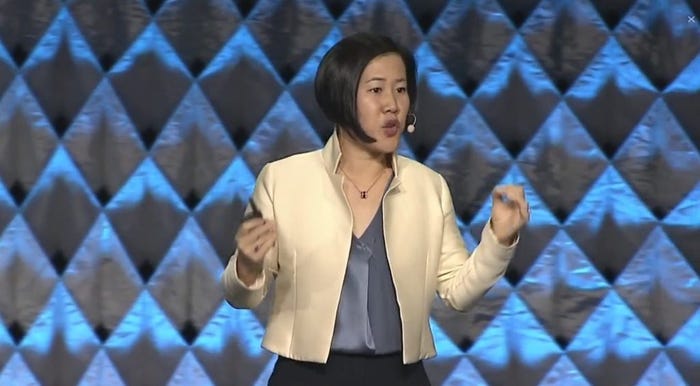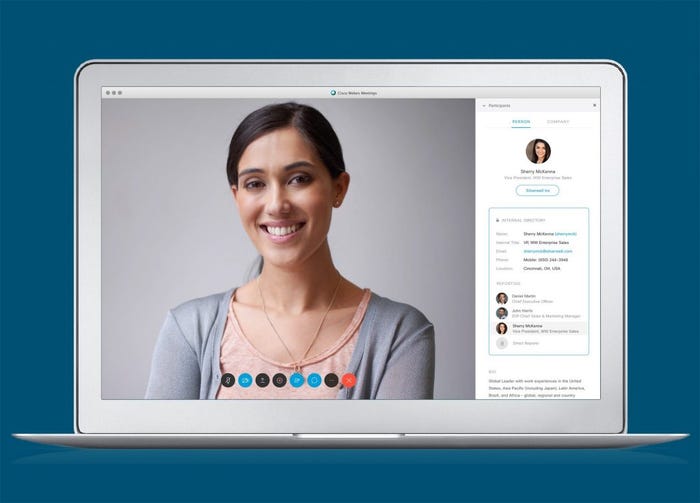Cisco Brings AI to Webex Meetings with ‘Cognitive Collaboration’
Cisco looks to bring more AI to meetings with its new Webex Assistant and People Insights.
March 26, 2019


Jeffrey Schwartz
By Jeffrey Schwartz
When Cisco acquired Accompany last year for $270 million, analysts hailed the deal as a pivotal move in the company’s effort to accelerate the implementation of AI into its collaboration and voice communications platforms. Cisco is now set to bring what it calls “cognitive collaboration,” which applies AI and machine learning, to its Webex Meetings, cloud PBX and contact-center offerings.
The Accompany acquisition paved the way for founder and CEO Amy Chang to lead Cisco’s collaboration technology group as senior vice president. Since the deal closed last year, Chang, who before launching Accompany spent seven years at Google on the development of Google Analytics, has maintained a low profile, preferring to wait until the new AI capabilities she envisioned were ready. At last week’s Enterprise Connect conference in Orlando, Chang outlined plans to deliver a virtual assistant to Webex Meetings and promised forthcoming AI capabilities coming to its Jabber call-center platform.

Cisco’s Amy Chang on stage at Enterprise Connect 2019.
“Cognitive collaboration is alive inside of Webex Meetings,” Chang said during a keynote address at the conference.
Starting with the release of Webex Assistant and Facial Recognition, set for June, Chang said Cisco will continue delivering new AI capabilities into Webex and start rolling out cognitive capabilities into its Jabber contact-center platform, although she was less specific on the latter, which involves its work with the Google Contact Center AI.
“You’re going to see us invest heavily in the contact-center space, because we have something massively different to help get customers to the right agent at the right time, every single time,” she said. “Watch this space, because you are going to see us deliver hit after hit for the next 18 months. It’s really, really going to change the way we’re able to help customers do customer experience.”
Cisco emphasized the integration of the core capabilities of Chang’s company, Accompany, into Webex Meetings with a feature called People Insights, designed to help workers be more prepared for meetings. According to a survey commissioned by Cisco by Dimensional Research, one-half of the 1,500 respondents said that LinkedIn didn’t provide them enough information to prepare for meetings, primarily because the information is static, and many don’t routinely update their profiles.
People Insights fills that gap by creating profiles of meeting attendees. It taps corporate directories and crawls the internet for other relevant public professional information such as news articles, blogs and industry electronic forums.
“It brings that context into the meeting about who you’re meeting with and it gives relevant talking points about those people you are interacting with,” Keith Griffin, Cisco’s team collaboration group CTO, told Channel Futures.
Griffin is the architect of the new Webex Assistant, which is deigned to understand basic voice commands, such as helping participants join a meeting, facilitate the sharing of files and requesting others to join. It’s the outgrowth of Cisco’s 2017 acquisition of MindMeld, whose Workbench conversational AI platform designed to combine natural language processing and dialog management.
Webex Assistant applies machine learning and uses AI to determine a participant’s intent; for example, if someone asks the virtual assistant to call someone with a common name, such as Michael, rather than taking the common approach of going through a corporate directory alphabetically, it will apply …
… context, such as which Michael interacts with the person making the request most frequently.
“It’s offering what we call a first match,” he said.
If the Webex Assistant doesn’t come up with the right person, it will make another attempt based on the information it has.
 “The machine learning at work is figuring out who most likely you intended to get to,” Griffin said.
“The machine learning at work is figuring out who most likely you intended to get to,” Griffin said.
Webex Meetings also supports new facial recognition and device-detection capabilities, to give participants a better sense of who is in the room and speaking.
Ben Johnson, founder and CEO of Liberty Technology, a managed services provider and Cisco partner, is among those who has worked with Cisco on some early field trials, and he’s bullish on the capabilities of Webex Assistant.
“With Webex Assistant, we will no longer need to have assistants start meetings for needy executives or assign a scribe to every meeting — we will have important tasks automatically assigned to the responsible individuals,” Johnson said. “It’s a grand vision, but a lot of it is already here. The technology works — and it’s really freaking cool.”
Cisco also is upgrading the video capabilities of Webex Meetings with support for high resolution of up to 30 frames per second. Also, Webex Meetings will support sharing of the Webex Boards whiteboarding offering. And Cisco has added a new Webex Meetings VDI application that allows participants to connect as a SIP call, thereby integrating audio and video.
Chang underscored the opportunity for partners she sees in bringing AI into collaboration, communications and meeting and add more capacity to serve increased use.
“It allows partners to build an entire practice around being very proactive with their large customers,” she said.
In addition, Cisco outlined new capabilities for its Webex Teams tool that provides instant messaging, call and meeting control, a whiteboard and the ability to share files. It will include support for non-Cisco, on-premises calling platforms, notably Skype for Business. Adding to the Microsoft OneDrive and SharePoint online integration, Microsoft Teams, it will also soon support Google Drive, Box, Dropbox and G Suite. Cisco also is adding the Webex Teams interface to Jabber, which until now only supported basic chat.
Finally, Cisco announced Webex Calling, which the company describes as an enterprise-grade, cloud-native PBX platform that brings together its BroadCloud and Webex platforms. Combined, this brings 29 million cloud PBX users together. It’s bundled with Webex Teams, with support for optional Cisco multiplatform (MPP) phones and video gear as well as Webex Meetings.
Read more about:
AgentsYou May Also Like
